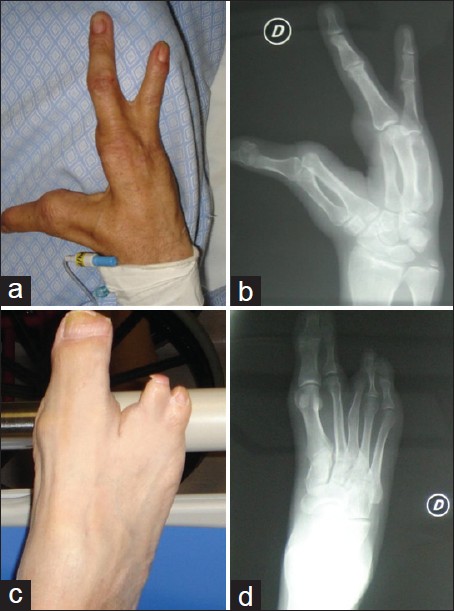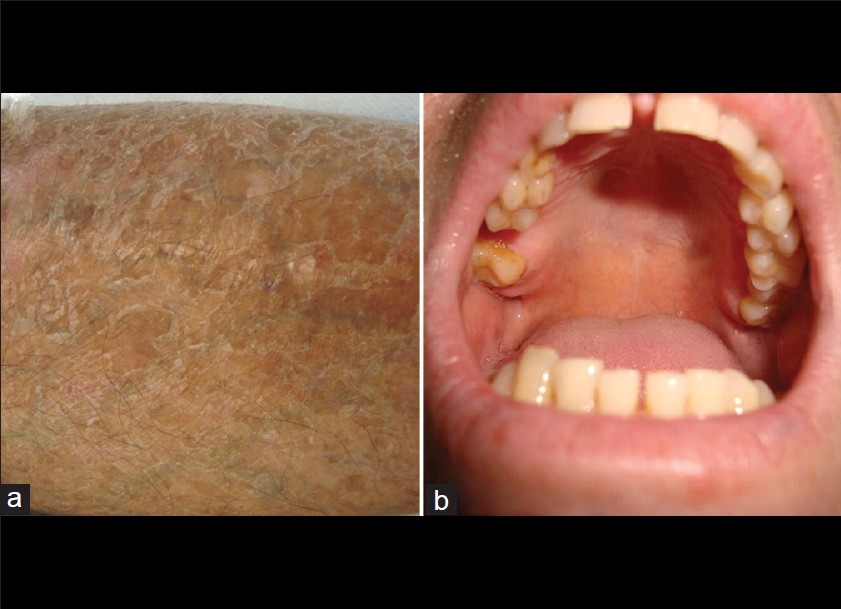Translate this page into:
A sporadic case of oligosymptomatic ectrodactyly-ectodermal dysplasia-clefting syndrome
Correspondence Address:
Adone Baroni
c/o II Policlinico, Edificio 3, Quarto piano, Via Pansini 5 - 80131 Napoli
Italy
| How to cite this article: Baroni A, Piccolo V, Di Maio R, Russo T. A sporadic case of oligosymptomatic ectrodactyly-ectodermal dysplasia-clefting syndrome. Indian J Dermatol Venereol Leprol 2012;78:521 |
Sir,
Ectrodactyly-ectodermal dysplasia-clefting (EEC) syndrome is an inherited disorder resulting from defects in early development of the embryo. The name EEC syndrome was first used in 1970 by Rudiger et al. who described a girl with trimelic ectrodactyly, ectodermal dysplasia, and bilateral cleft lip and palate. [1] Herein, we report a singular case of a sporadic and oligosymptomatic EEC syndrome.
A 39-year-old man, born from healthy non-consanguineous parents, was referred to our department for his nail anomalies and skin dryness, but during patient observation, his hands and feet deformity aroused our attention.
Clinical examination revealed a total nail dystrophy, characterized by a slow growth, yellowing distal part, white transverse ridges and thinning [Figure - 1]a-c. There were no signs of nail psoriasis, and fungal and bacterial cultures of the nails produced a negative result. His skin appeared dry and ichthyosiform [Figure - 2]a; further, he lamented a decreased sweating and a heat intolerance, suggestive of hypohidrosis.
 |
| Figure 1: (a, c), Right hand and right foot showing ectrodactyly as well as dystrophic nails. (b, d), X-rays of right hand showed agenesis of phalanges of the second and the third finger; the heads of the second and the third metacarpal bones were articulated respectively with the bases of proximal phalanges of the first and the fourth finger; X-rays of right foot showed agenesis of phalanges of the third toe |
 |
| Figure 2: (a) Skin of lower limbs appears dry and scaly (b) Highly arched palate and a normal dentition |
Physical examination of both hands and feet showed ectrodactyly and syndactyly [Figure - 1]a-c. X-ray of hands and feet revealed the absence of some dactylic segments and the fusion of others [Figure - 1]b-d.
Mucosae and hair were normal. Odontostomatologic examination revealed a highly arched palate and a normal dentition [Figure - 2]b. Examination of eyes, hearing and external genitalia did not show abnormalities, and a multidisciplinary team confirmed that there were no more body anomalies. The patient had a normal intellectual development and a good cultural level. No other family members were known to be affected by this disease.
Based on anamnestic, clinical and radiological findings, a diagnosis of sporadic oligosymptomatic ectrodactyly-ectodermal dysplasia-clefting syndrome was made.
EEC syndrome is a rare, multiple congenital syndrome with autosomal dominant inheritance and incomplete penetrance, [2],[3] characterized by a highly variable clinical expression. Sporadic forms are very rare and generally the most severe. [4]
EEC syndrome consists of ectrodactyly (E), ectodermal dysplasia (E) and cleft lip (C) with or without cleft palate. [5] The ectodermal component can involve hair (hypotrichosis and hypopigmentation), teeth (hypodontia, microdontia and enamel dysplasia), nails (dystrophic in most case) and sweating (hypohidrosis). In addition to the 3 cardinal features of the EEC syndrome, other manifestations are often reported: tear duct anomalies, urogenital malformations, mental retardation, nipple anomalies, comedo nevus, choanal atresia, a reduced number of meibomian orifices, ear anomalies, conductive hearing loss, breathy voice, hypopituitarism and growth hormone deficiency. [1],[2] The term "oligosymptomatic EEC syndrome" refers to cases of EEC, expressing only one or a few signs. [4]
Ectrodactyly, also called lobster claw or split hand-foot malformation (SHFM), is characterized by aberrant development of the central digital rays with absence of fingers or toes, a deep median cleft and fusion of the remaining digits. This anomaly can be isolated or can be in combination with other anomalies (syndromic ectrodactyly). As it happens in our patient, it is often accompanied by syndactyly. [4]
EEC syndrome is the prototype of the syndromes, characterized by the presence of heterozygote mutation in the p63 gene in most patients. [5]
Differential diagnosis includes also other dominantly inherited syndromes that share similarity with EEC syndrome: Lacrimo-auriculo-dento-digital syndrome (LADD); acro-dermato-ungual-lacrimal-tooth syndrome (ADULT); ankyloblepharon-ectodermal dysplasia-clefting syndrome (AEC); limb-mammary syndrome (LMS); curly hair-ankyloblepharon-nail dysplasia syndrome (CHANDS); cleft lip/palate-ectodermal dysplasia syndrome (CLPED1). [5]
We have described this rare, mildly symptomatic and sporadic case to confirm an exceptional clinical variability and unpredictable expressivity of particular EEC syndrome that can make a man a really mythological figure.
| 1. |
Rüdiger RA, Haase W, Passarge E. Association of ectrodactyly, ectodermal dysplasia, and cleft lip-palate. Am J Dis Child 1970;120:160-3.
[Google Scholar]
|
| 2. |
Fernandes B, Ruas E, Machado A, Figueiredo A. Ectrodactyly-ectodermal dysplasia-clefting syndrome (EEC): report of a case with perioral papillomatosis. Pediatr Dermatol 2002;19:330-2.
[Google Scholar]
|
| 3. |
Rodini ES, Richieri-Costa A. EEC syndrome: report on 20 new patients, clinical and genetic considerations. Am J Med Genet 1990;37:42-53.
[Google Scholar]
|
| 4. |
Bigatà X, Bielsa I, Artigas M, Azón A, Ribera M, Ferrándiz C. The ectrodactyly-ectodermal dysplasia-clefting syndrome (EEC): report of five cases. Pediatr Dermatol 2003;20:113-8.
[Google Scholar]
|
| 5. |
Brunner HG, Hamel BC, Van Bokhoven H. The p63 gene in EEC and other syndromes. J Med Genet 2002;39:377-81.
[Google Scholar]
|
Fulltext Views
2,040
PDF downloads
1,591





